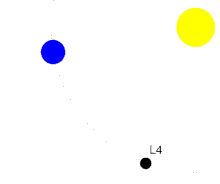Theia (planet)

Theia is a hypothetical planet that is thought to have hit the Earth 4.5 billion years ago.[1] The theory says that Theia, a Mars sized planet, hit the Earth and the debris from the impact formed the Moon.[2][3] It is also thought that the Earth's water came from Theia.[4]
Name
[change | change source]Theia was named after Theia, the Greek goddess of sight.[5]
Composition
[change | change source]Theia could have been made of enstatite and chondrite,[6] though this isn't a proven fact. It is believed, however, that Theia was rich in iron.[7]

According to NASA, it is possible that once Theia crashed, it was destroyed. The debris from both the Earth and Theia merged, and formed two bodies. The bigger one was absorbed into Earth by its gravity, and the smaller one was pushed far enough that it wasn't absorbed, but close enough that it stayed in orbit. That smaller body became the Moon.[8][9]
References
[change | change source]- ↑ Carpenter, Katie Grace (2024-11-04). "Scientists Say: Theia". Retrieved 2024-11-30.
- ↑ Wolpert, Stuart (January 12, 2017). "UCLA Study Shows the Moon is Older Than Previously Thought". scitechdaily.com. UCLA. Retrieved 23 March 2022.
- ↑ "Collision May Have Formed the Moon in Mere Hours, Simulations Reveal - NASA". 2022-10-04. Retrieved 2024-11-30.
- ↑ Budde, Gerrit; Burkhardt, Christoph; Kleine, Thorsten (2019-05-20). "Molybdenum isotopic evidence for the late accretion of outer Solar System material to Earth". Nature Astronomy. 3 (8): 736–741. Bibcode:2019NatAs...3..736B. doi:10.1038/s41550-019-0779-y. ISSN 2397-3366. S2CID 181460133.
- ↑ "THEIA - Greek Titan Goddess of Sight & Heavenly Light". www.theoi.com. Retrieved 2024-11-30.
- ↑ Desch, Steven J.; Robinson, Katharine L. (2019-12-01). "A unified model for hydrogen in the Earth and Moon: No one expects the Theia contribution". Geochemistry. In Honor to Prof. Keil. 79 (4): 125546. doi:10.1016/j.chemer.2019.125546. ISSN 0009-2819.
- ↑ Zisk, Rachael (2023-11-02). "Researchers Find Possible Traces of Theia Under the Earth's Surface". Payload. Retrieved 2024-11-30.
- ↑ "Collision May Have Formed the Moon in Mere Hours, Simulations Reveal - NASA". 2022-10-04. Retrieved 2024-12-09.
- ↑ NASA's Ames Research Center (2022-10-04), New Supercomputer Simulation Sheds Light on Moon’s Origin, retrieved 2024-11-30
